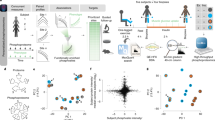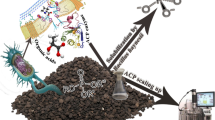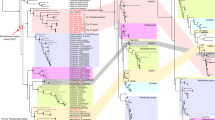Abstract
Enhanced biological phosphorus removal (EBPR) selects for polyphosphate accumulating microorganisms to achieve phosphate removal from wastewater. We used high-resolution community proteomics to identify key metabolic pathways in ‘Candidatus Accumulibacter phosphatis’ (A. phosphatis)-mediated EBPR and to evaluate the contributions of co-existing strains within the dominant population. Overall, 702 proteins from the A. phosphatis population were identified. Results highlight the importance of denitrification, fatty acid cycling and the glyoxylate bypass in EBPR. Strong similarity in protein profiles under anaerobic and aerobic conditions was uncovered (only 3% of A. phosphatis-associated proteins exhibited statistically significant abundance differences). By comprehensive genome-wide alignment of 13 930 orthologous proteins, we uncovered substantial differences in protein abundance for enzyme variants involved in both core-metabolism and EBPR-specific pathways among the A. phosphatis population. These findings suggest an essential role for genetic diversity in maintaining the stable performance of EBPR systems and, hence, demonstrate the power of integrated cultivation-independent genomics and proteomics for the analysis of complex biotechnological systems.
Similar content being viewed by others
Log in or create a free account to read this content
Gain free access to this article, as well as selected content from this journal and more on nature.com
or
References
Abe T, Sugawara H, Kinouchi M, Kanaya S, Ikemura T . (2005). Novel phylogenetic studies of genomic sequence fragments derived from uncultured microbe mixtures in environmental and clinical samples. DNA Res. 12: 281–290.
Altschul SF, Madden TL, Schäffer AA, Zhang J, Zhang Z, Miller W et al. (1997). Gapped BLAST and PSI-BLAST: a new generation of protein database search programs. Nucleic Acids Res 25: 3389–3402.
Bell T, Newman JA, Silverman BW, Turner SL, Lilley AK . (2005). The contribution of species richness and composition to bacterial services. Nature 436: 1157–1160.
Benjamini Y, Hochberg Y . (1995). Controlling the false discovery rate: a practical and powerful approach to multiple testing. J R Statist Soc B 57: 289–300.
Blackall LL, Crocetti GR, Saunders AM, Bond PL . (2002). A review and update of the microbiology of enhanced biological phosphorus removal in wastewater treatment plants. Antonie van Leeuwenhoek 81: 681–691.
Bond PL, Hugenholtz P, Keller J, Blackall LL . (1995). Bacterial community structures of phosphate-removing and non-phosphate-removing activated sludges from sequencing batch reactor. Appl Environ Microbiol 61: 1910–1916.
Correll DL . (1998). The role of phosphorus in the eutrophication of receiving waters: a review. J Environ Qual 27: 261–266.
Crocetti GR, Banfield JF, Keller J, Bond PL, Blackall LL . (2002). Glycogen-accumulating organisms in laboratory-scale and full-scale wastewater treatment process. Microbiology 148: 3353–3364.
Crocetti GR, Hugenholtz P, Bond PL, Schuler A, Keller J, Jenkins D et al. (2000). Identification of polyphosphate-accumulating organisms and design of 16S rRNA-directed probes for their detection and quantification. Appl Environ Microbiol 66: 1175–1182.
Denef VJ, Shah MB, VerBerkmoes NC, Hettich RL, Banfield JF . (2007). Implications of strain- and species-level sequence divergence for community and isolate shotgun proteomic analysis. J Proteome Res 6: 3152–3161.
Eng JK, McCormack AL, Yates III JR . (1994). An approach to correlate tandem mass spectral data of peptides with amino acid sequences in a protein database. J Am Soc Mass Spectrom 5: 976–989.
Eng S-E, Mann M . (2005). Mass spectrometry-based proteomics turn quantitative. Nat Chem Biol 1: 252–262.
Engelhardt KAM, Ritchie ME . (2002). The effect of aquatic plant species richness on wetland ecosystem processes. Ecology 83: 2911–2924.
Florens L, Carozza MJ, Swanson SK, Fournier M, Coleman MK, Workman JL et al. (2006). Analysing chromatin remodeling complexes using shotgun proteomics and normalized spectral abundance factors. Methods 40: 303–311.
García Martín H, Ivanova N, Kunin V, Warnecke F, Barry KW, McHardy AC et al. (2006). Metagenomic analysis of two enhanced biological phosphorus removal (EBPR) sludge communities. Nat Biotechnol 24: 1263–1269.
He S, Gall DL, McMahon KD . (2007). ″Candidatus Accumulibacter″ population structure in enhanced biological phosphorus removal sludges as revealed by polyphosphate kinase genes. Appl Environ Microbiol 73: 5865–5874.
Hesketh AR, Chandra G, Shaw AD, Rowland JJ, Kell DB, Bibb MJ et al. (2002). Primary and secondary metabolism, and post-translational protein modifications, as portrayed by proteomic analysis of Streptomyces coelicolor. Mol Microbiol 46: 917–932.
Hesselmann RPX, Von Rummell R, Resnick SM, Hany R, Zehnder AJB . (2000). Anaerobic metabolism of bacteria performing enhanced biological phosphate removal. Water Res 34: 3487–3494.
Hesselmann RPX, Werlen C, Hahn D, van der Meer JR, Zehnder AJB . (1999). Enrichment, phylogenetic analysis and detection of a bacterium that performs enhanced biological phosphate removal in activated sludge. Syst Appl Microbiol 22: 454–465.
Johnson ZI, Zinser ER, Coe A, McNulty NP, Woodward EMS, Chisholm SW . (2006). Niche partitioning among Prochlorococcus ecotypes along ocean-scale environmental gradients. Science 311: 1737–1739.
Kohonen T . (1990). The self-organizing map. Proc IEEE 78: 1464–1480.
Kong Y, Nielsen JL, Nielsen PH . (2004). Microautoradiographic study of Rhodocyclus-related polyphosphate-accumulating bacteria in full-scale enhanced biological phosphorus removal plants. Appl Environ Microbiol 70: 5383–5390.
Kong Y, Xia Y, Nielsen JL, Nielsen PH . (2005). Ecophysiology of a group of uncultured gammaproteobacterial glycogen-accumulating organisms in full-scale enhanced biological phosphorus removal wastewater treatment plants. Environ Microbiol 8: 479–489.
Kornberg A, Rao NN, Ault-Riche D . (1999). Inorganic polyphosphate: a molecule of many functions. Annu Rev of Biochem 68: 89–125.
Lo I, Denef VJ, VerBerkmoes NC, Shah MB, Goltsman D, DiBartolo G et al. (2007). Strain-resolved community proteomics reveals recombining genomes of acidophilic bacteria. Nature 446: 537–541.
Louie TM, Mah TJ, Oldham W, Ramey WD . (2000). Use of metabolic inhibitors and gas chromatography/mass spectrometry to study poly-β-hydroxyalkanoates metabolism involving cryptic nutrients in enhanced biological phosphorus removal systems. Water Res 34: 1507–1514.
Ludwig W, Strunk O, Westram R, Richter L, Meier H, Yadhukumar et al. (2004). ARB: a software environment for sequence data. Nucleic Acids Res 32: 1363–1371.
Markowitz VM, Korzeniewski F, Palaniappan K, Szeto E, Werner G, Padki A et al. (2006). The integrated microbial genomes (IMG) system. Nucleic Acids Res 34: D344–D348.
McHardy AC, García Martín H, Tsirigos A, Hugenholtz P, Rigoutsos I . (2007). Accurate phylogenetic classification of variable-length DNA fragments. Nat Methods 4: 63–72.
McMahon KD, Dojka MA, Pace NR, Jenkins D, Keasling JD . (2002). Polyphosphate kinase from activated sludge performing enhanced biological phosphorus removal. Appl Environ Microbiol 68: 4971–4978.
Mino T, van Loosdrecht MCM, Heijnen JJ . (1998). Microbiology and biochemistry of the enhanced biological phosphate removal process. Water Res 32: 3193–3207.
Oehmen A, Yuan Z, Blackall LL, Keller J . (2005). Comparison of acetate and propionate uptake by polyphosphate accumulating organisms and glycogen accumulating organisms. Biotechnol Bioeng 91: 162–168.
Pereira H, Lemos PC, Reis MAM, Crespo JPSG, Carrondo MJT, Santos H . (1996). Model for carbon metabolism in biological phosphorus removal processes based on in vivo13C-NMR labelling experiments. Water Res 30: 2128–2138.
Ram RJ, VerBerkmoes NC, Thelen MP, Tyson GW, Baker BJ, Blake II RC et al. (2005). Community proteomics of a natural microbial biofilm. Science 308: 1915–1920.
Richardson DJ, Berks BC, Russell DA, Spiro S, Taylor CJ . (2001). Functional, biochemical and genetic diversity of prokaryotic nitrate reductases. Cell Mol Life Sci 58: 165–178.
Schramm A, De Beer D, Van den Heuvel JC, Ottengraf S, Amann R . (1999). Microscale distribution of populations and activities of Nitrosospira and Nitrospira spp. along a macroscale gradient in a nitrifying bioreactor: quantification by in situ hybridization and the use of microsensors. Appl Environ Microbiol 65: 3690–3696.
Schuler AJ, Jenkins D . (2003). Enhanced biological phosphorus removal from wastewater by biomass with different phosphorus contents, Part III: Anaerobic sources of reducing equivalents. Water Environ Res 75: 512–522.
Seviour RJ, Mino T, Onuki M . (2003). The microbiology of biological phosphorus removal in activated sludge systems. FEMS Microbiol Rev 27: 99–127.
Srinath EG, Sastry CA, Pillai SC . (1959). Rapid removal of phosphorus from sewage by activated sludge. Experientia 15: 339–340.
Steen H, Mann M . (2004). The ABC's (and XYZ's) of peptide sequencing. Nat Rev Mol Cell Biol 5: 699–711.
Tabb DL, McDonald WH, Yates III JR . (2002). DTASelect and contrast: tools for assembling and comparing protein identifications from shotgun proteomics. J Proteome Res 1: 21–26.
Tyers M, Mann M . (2003). From genomics to proteomics. Nat Biotechnol 422: 193–197.
Ultsch A, Moerchen F . (2005). ESOM-Maps: tools for clustering, visualization, and classification with Emergent SOM. Technical Report of the Department of Mathematics and Computer Science, University of Marburg, Germany 46: 1–7.
United Nations World Water Assessment Programme (2006). The United Nations World Water Development Report 2. United Nations Educational, Scientific and Cultural Organization (UNESCO) and Berghahn Books: Paris and New York, France and USA.
White D . (2007). The Physiology and Biochemistry Of Prokaryotes. Oxford University Press: New York, USA.
Wilmes P, Bond PL . (2004). The application of two-dimensional polyacrylamide gel electrophoresis and downstream analyses to a mixed community of prokaryotic microoganisms. Environ Microbiol 6: 911–920.
Wilmes P, Bond PL . (2006a). Metaproteomics: studying functional gene expression in microbial ecosystems. Trends Microbiol 14: 92–97.
Wilmes P, Bond PL . (2006b). Towards exposure of elusive metabolic mixed-culture processes: the application of metaproteomic analyses to activated sludge. Water Sci Technol 54: 217–226.
Wilmes P, Wexler M, Bond PL . (2008). Metaproteomics provides functional insight into activated sludge wastewater treatment. PLoS ONE 3: 1–11 e1778. doi:10.1371/journal.pone.0001778.
Zeng RJ, Saunders AM, Yuan Z, Blackall LL, Keller J . (2003). Identification and comparison of aerobic and denitrifying polyphosphate-accumulating organisms. Biotechnol Bioeng 83: 140–148.
Acknowledgements
We thank Phil Hugenholtz, Héctor García Martín and Ernest Szeto for provision of the genomic information. Furthermore, we thank Vincent Denef, Greg Dick and Sheri Simmons for helpful comments and discussions. Funding was provided by the United States Department of Energy Genomics:GTL Program (Office of Science). AA was supported by a grant from the Swedish Research Council.
Author information
Authors and Affiliations
Corresponding authors
Additional information
Supplementary Information accompanies the paper on The ISME Journal website (http://www.nature.com/ismej)
Supplementary information
Rights and permissions
About this article
Cite this article
Wilmes, P., Andersson, A., Lefsrud, M. et al. Community proteogenomics highlights microbial strain-variant protein expression within activated sludge performing enhanced biological phosphorus removal. ISME J 2, 853–864 (2008). https://doi.org/10.1038/ismej.2008.38
Received:
Revised:
Accepted:
Published:
Issue date:
DOI: https://doi.org/10.1038/ismej.2008.38
Keywords
This article is cited by
-
Dynamic character displacement among a pair of bacterial phyllosphere commensals in situ
Nature Communications (2022)
-
TbasCO: trait-based comparative ‘omics identifies ecosystem-level and niche-differentiating adaptations of an engineered microbiome
ISME Communications (2022)
-
Using high-abundance proteins as guides for fast and effective peptide/protein identification from human gut metaproteomic data
Microbiome (2021)
-
Mining traits for the enrichment and isolation of not-yet-cultured populations
Microbiome (2019)
-
Meta-proteomic analysis of protein expression distinctive to electricity-generating biofilm communities in air-cathode microbial fuel cells
Biotechnology for Biofuels (2018)



